Restaurant style Vegetable Biryani
Aromatic and flavorful restaurant style Vegetable Biryani! This fragrant biryani is packed with veggies, spices, herbs and nuts and is an explosion of flavors in every bite!
This post may contain affiliate links. Please read our disclosure policy.
Nothing like a good plate of aromatic biryani! This Vegetable Biryani hits all the right spots with its wonderful aroma and exotic flavors!
Loaded with veggies, crunchy cashews, warm spices like saffron, herbs like cilantro and mint, this biryani is a delight to the taste buds in every bite!
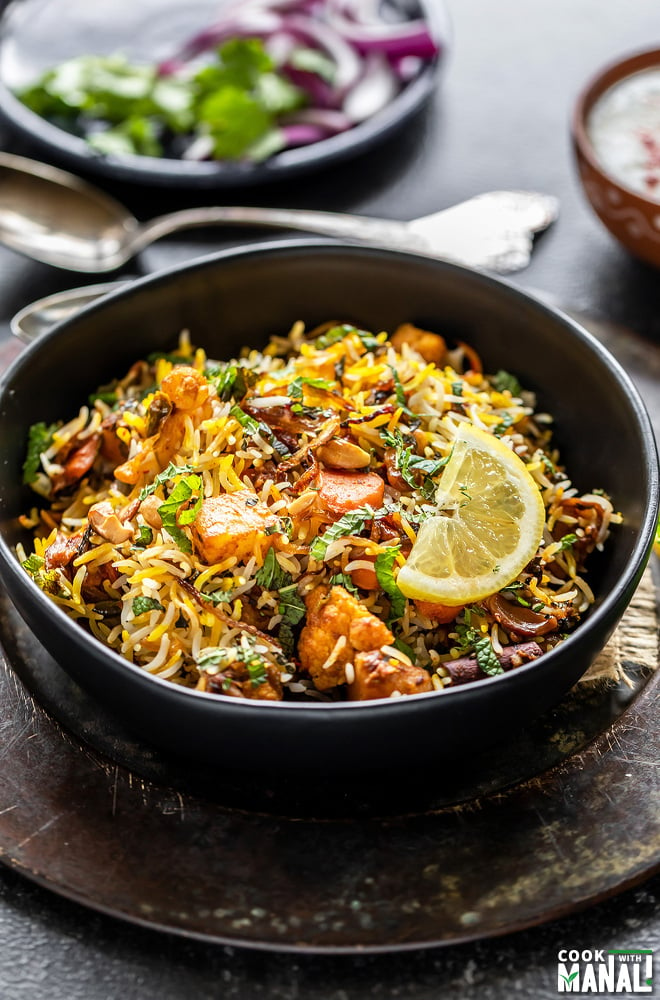
Disclosure: This post contains affiliate links. For more information on my Affiliate and Advertising Policy, please click here.
So, I know that more often that not, vegetable biryani is looked down upon.
I have often heard people call it “pulao” and claiming that an actual biryani should have meat in it.
While I don’t know how accurate that claim is, I still think that a very good Vegetable Biryani is very much possible which is very different from a pulao.
For me pulao is a short cut one-pot meal (like this beetroot pulao) which I make when I am in mood for easy dinner.
On the other hand, I make biryani for special occasions. It’s a multi-step process, takes time and is not something I would make for a weekday dinner.
I can 100% guarantee you that even if you don’t think much of veg biryani, this one will change your mind!
It’s super flavorful, packed with so many flavors and will entice your taste buds in every bite!
I won’t say this is an easy or super quick recipe because it’s not.
The recipe takes time, there are multiple steps. So reserve this dish for special occasions.
It is well worth the effort though, that much I can guarantee!
What is Biryani
Biryani is a rice dish made with layers of rice, spices and traditionally meat (but it our case veggies!).
Here are the key components of biryani:
Rice: of course rice is the base and key ingredient of this dish. Long grain basmati rice is what is traditionally used.
I highly recommend using extra-long grain aged basmati rice for biryani. I use the Zebra Sella Basmati Rice and it works so well.
Veggies: so traditionally meat is used in biryani but since we are making veg biryani, we are using assorted vegetables here.
I have used potato, cauliflower, beans and carrots.
You can use green peas, mushrooms or even paneer would be a good addition.
Spices: aromatic and exotic spices (both whole and ground) are a must for a good biryani. Most commonly used are cardamom, peppercorns, cumin, saffron, garam masala.
Also rose water or kewra water is often used to flavor the biryani.
Fresh herbs & nuts: herbs like mint, cilantro and nuts like cashews are often added as garnishing and to add more texture and flavors to the biryani.
Caramelized onions also make a great addition.
The veggies and rice are layered and the biryani is then cooked on low heat with some heavy object placed on top of the pot of biryani.
This process is called “dum” and hence it’s also known as Vegetable Dum Biryani.
Tips to Make Restaurant Style Veg Biryani
So, now that we know the key components for biryani, let’s see how to make restaurant style vegetable biryani!
Choose the right rice: long grain basmati rice is what you should be using to make biryani.
My recommendation is Zebra Sella Basmati rice. It has extra long grains and it works perfectly well in biryani.
Using fresh ingredients: like mince your own fresh ginger, garlic and chilies.
I often use store bought ginger-garlic paste when I am short on time but for biryani, I always crush them fresh using my mortar and pestle.
It makes a difference and you would have to trust me on that.
Pan-frying the veggies before cooking them: so before cooking the veggies, I like to pan fry them a little. This gives the veggies a nice texture.
We don’t want over-cooked vegetable in a veg biryani so this extra-step helps.
Using fresh herbs & spices: I really like to flavor my biryani with all the herbs and spices.
So, I use saffron milk (which is made by mixing saffron with warm milk) and also use rose water for the final flavor.
Of course, I also use plenty of cilantro and mint.
Drizzle ghee on top: I like to drizzle some ghee as I layer the biryani. It really elevates the flavor.
Don’t forget to drizzle some extra ghee on top before cooking the biryani at the last step.
Don’t cut down on the fat: this is not health food you guys, so don’t cut down on steps like frying the onions in ghee.
It’s something you make once in a while so no harm in indulging. Right?
Can you Make this Vegetable Biryani Vegan?
Absolutely, super simple!
- skip the ghee
- replace plain yogurt with non-dairy yogurt (like almond milk yogurt) or with coconut milk
- use non-dairy milk to make the saffron milk
Follow rest of the steps as it is.
So let’s see how make this vegetable biryani!
Method
Cook the rice
Soak the rice in 3 cups (24 oz) water for 30 minutes.
After the rice has soaked, drain the water using a colander.
1- Heat a pot full of water, add 3 green cardamom, 2 cloves and 3/4 teaspoon salt to it. Let it come to a boil.
2- Add rice, stir with a spoon.
3- Let it cook uncovered (don’t lower the heat) until it’s almost cooked (around 70-75% cooked but not fully cooked). There should be a bite to it. This takes around 6 to 7 minutes.
4- Remove pan from heat and drain rice in a colander. You may add a teaspoon of ghee to the rice. Set aside.
Caramelize onion & cashews and pan fry the veggies
5- Heat 1.5 tablespoons ghee in a pan on medium heat. Once hot, add 1 sliced onion to it and cook until they turn golden brown and caramelize.
This takes around 8 to 9 minutes. Remove on a plate.
6- To the same pan, now add cashews and cook until golden brown, around 1 to 2 minutes. Remove on plate and set aside.
7- To same pan add potato, cook for 2 minutes until light brown. Remove on a plate.
8- To the same pan, now add cauliflower, beans and carrots. Saute for 2 to 3 minutes until veggies appear light brown. Remove on a plate.
PS: This pan-frying veggies is an additional step and you can skip it and directly cook the veggies later on. I like doing the extra step as it gives the veggies a nice texture.
Make the saffron-milk and cook the vegetables
9- Heat 2 tablespoons milk in a pan. Once warm, add saffron strands (crush it before adding).
Let it sit for 10 minutes for that beautiful yellow color. Saffron milk is ready, set it aside.
10- Crush ginger, garlic and chili using a mortar and pestle. Set aside.
11- Heat 1.5 tablespoons oil in a pan/pot on medium heat. Add cumin seeds, cinnamon stick, bay leaf, peppercorns, remaining 3 cardamom and remaining 2 cloves.
Stir and let the spices sizzle for few seconds. Add the sliced onions also add 1/4 teaspoon salt.
12- Cook for 3 to 4 minutes until onions turn light brown. Then add the crushed ginger-garlic and green chilies paste.
Cook for 2 minutes until the raw smell goes away.
13- Remove pan from heat and whisk in the yogurt, whisking continuously until it’s all absorbed.
Put the pan back on heat. Add all the veggies and toss to combine.
14- Add the biryani masala and kashmiri red chili powder.
15- Add 1/4 cup water. Let it cook for around 6 to 7 minutes until veggies are almost cooked but not overcooked. They should be firm to bite.
You may also cover the pan, I usually cook uncovered. There shouldn’t be much water left, it should be kind of thick mixture.
Remove from heat.
Layer the biryani
17- Now take a heavy bottom pan. I first grease the bottom of the pan with ghee.
18- Then add a layer of rice (half of the rice).
19- Top with half of fried onion, half of fried cashews and half of cilantro and mint. Add 1/2 teaspoon of rose water.
20- Now place the veggies on top (all of it).
21- Then add the remaining rice on top of the veggies. Then top it with remaining with fried onion, cashews, cilantro and mint.
Add the prepared saffron milk on top.
22- Add the remaining 1 teaspoon rose water on top.
23- And finally drizzle 1 teaspoon ghee on top. Sprinkle some biryani masala.
24- I did 2 layers of rice and 1 layer of veggies. If your pan in small you may do more layers, but the end layer should always be of rice.
Cover the pan tightly with aluminium foil. Then cover with a fitted lid.
Heat a flat pan on medium heat. Once hot, reduce the flame to lowest. Place your biryani pot on top of the pan and let it cook for 25 to 30 minutes on lowest heat (dum).
Scoop out the biryani from the bottom of the pan so that each serving has both the veggies and the rice.
Serve vegetable biryani with a side of raita.
If you’ve tried this Restaurant Style Vegetable Biryani Recipe then don’t forget to rate the recipe! You can also follow me on Facebook and Instagram to see what’s latest in my kitchen!
Restaurant Style Vegetable Biryani
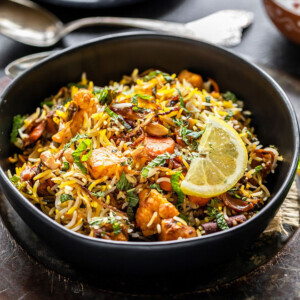
Ingredients
- 1 cup basmati rice 200 grams, soaked in 3 cups (24 oz) water for 30 minutes
- 6 whole green cardamom divided
- 4 cloves divided
- 1 teaspoon salt divided
- 1.5 tablespoon +1 teaspoon ghee divided
- 2 medium red onion thinly sliced, divided
- 2 tablespoons broken cashews
- 1 small potato cubed
- 1/2 cup cauliflower florets medium sized florets
- 1 medium carrot cut diagonally
- 5-6 green beans cut diagonally
- 2 tablespoons milk 30 ml
- saffron strands generous pinch
- 1 inch ginger crushed
- 4-5 large garlic cloves crushed
- 2 green chilies crushed
- 1.5 tablespoons oil 22 ml
- 1/2 teaspoon cumin seeds I used shahi jeera
- 1 inch cinnamon stick
- 1 bay leaf
- 3 whole black peppercorns
- 1/3 cup plain yogurt whisked and at room temperature, can add 1/4 teaspoon cornstarch and whisk to prevent curdling
- 1.5 teaspoon biryani masala or use 1 teaspoon garam masala
- 1/2 teaspoon kashmiri red chili powder or use regular chili powder for heat
- 1/4 cup water
- 2 tablespoons chopped cilantro
- 2 tablespoons chopped mint
- 1.5 teaspoon rose water or kewra water
Instructions
Cook the rice
- Soak the rice in 3 cups (24 oz) water for 30 minutes. After the rice has soaked, drain the water using a colander.
- Heat a pot full of water, add 3 green cardamom, 2 cloves and 3/4 teaspoon salt to it. Let it come to a boil.Add rice, stir with a spoon.
- Let it cook uncovered (don't lower the heat) until it's almost cooked (around 70-75% cooked but not fully cooked). There should be a bite to it. This takes around 6 to 7 minutes.Remove pan from heat and drain rice in a colander. You may add a teaspoon of ghee to the rice. Set aside.
Caramelize onion & cashews and pan fry the veggies
- Heat 1.5 tablespoons ghee in a pan on medium heat. Once hot, add 1 sliced onion to it and cook until they turn golden brown and caramelize.This takes around 8 to 9 minutes. Remove on a plate.
- To the same pan, now add cashews and cook until golden brown, around 1 to 2 minutes. Remove on plate and set aside.
- To same pan add potato, cook for 2 minutes until light brown. Remove on a plate.
- To the same pan, now add cauliflower, beans and carrots. Saute for 2 to 3 minutes until veggies appear light brown. Remove on a plate.PS: This pan-frying veggies is an additional step and you can skip it and directly cook the veggies later on. I like doing the extra step as it gives the veggies a nice texture.
Make the saffron-milk and cook the vegetables
- Heat 2 tablespoons milk in a pan. Once warm, add saffron strands (crush it before adding).Let it sit for 10 minutes for that beautiful yellow color. Saffron milk is ready, set it aside.
- Crush ginger, garlic and chili using a mortar and pestle. Set aside.
- Heat 1.5 tablespoons oil in a pan/pot on medium heat. Add cumin seeds, cinnamon stick, bay leaf, peppercorns, remaining 3 cardamom and remaining 2 cloves.Stir and let the spices sizzle for few seconds. Add the sliced onions also add 1/4 teaspoon salt.
- Cook for 3 to 4 minutes until onions turn light brown. Then add the crushed ginger-garlic and green chilies paste.Cook for 2 minutes until the raw smell goes away.
- Remove pan from heat and whisk in the yogurt, whisking continuously until it's all absorbed.Put the pan back on heat. Add all the veggies and toss to combine.
- Add the biryani masala and kashmiri red chili powder.
- Add 1/4 cup water. Let it cook for around 6 to 7 minutes until veggies are almost cooked but not overcooked. They should be firm to bite.You may also cover the pan, I usually cook uncovered. There shouldn't be much water left, it should be kind of thick mixture.Remove from heat.
Layer the biryani
- Now take a heavy bottom pan. I first grease the bottom of the pan with ghee.Then add a layer of rice (half of the rice). Top with half of fried onion, half of fried cashews and half of cilantro and mint. Add 1/2 teaspoon of rose water. Now place the veggies on top (all of it).
- Then add another rice layer (remaining rice) on top of the veggies. Then top it with remaining with fried onion, cashews, cilantro and mint.Add the prepared saffron milk and the remaining 1 teaspoon rose water on top.
- And finally drizzle 1 teaspoon ghee on top. Sprinkle some biryani masala.I did 2 layers of rice and 1 layer of veggies. If your pan in small you may do more layers, but the end layer should always be of rice.
- Cover the pan tightly with aluminium foil. Then cover with a fitted lid.Heat a flat pan on medium heat. Once hot, reduce the flame to lowest. Place your biryani pot on top of the pan and let it cook for 25 to 30 minutes on lowest heat (dum).
- Scoop out the biryani from the bottom of the pan so that each serving has both the veggies and the rice.Serve vegetable biryani with a side of raita.
Notes
- I haven't added lot of vegetables here since I wanted the rice to shine through. You can add more veggies if you like more veggies in your biryani.
- To make the biryani vegan, use vegan yogurt or coconut milk in place of plain yogurt. Skip the ghee and use non-dairy milk to make the saffron milk.
Nutrition
Nutrition information is automatically calculated, so should only be used as an approximation.
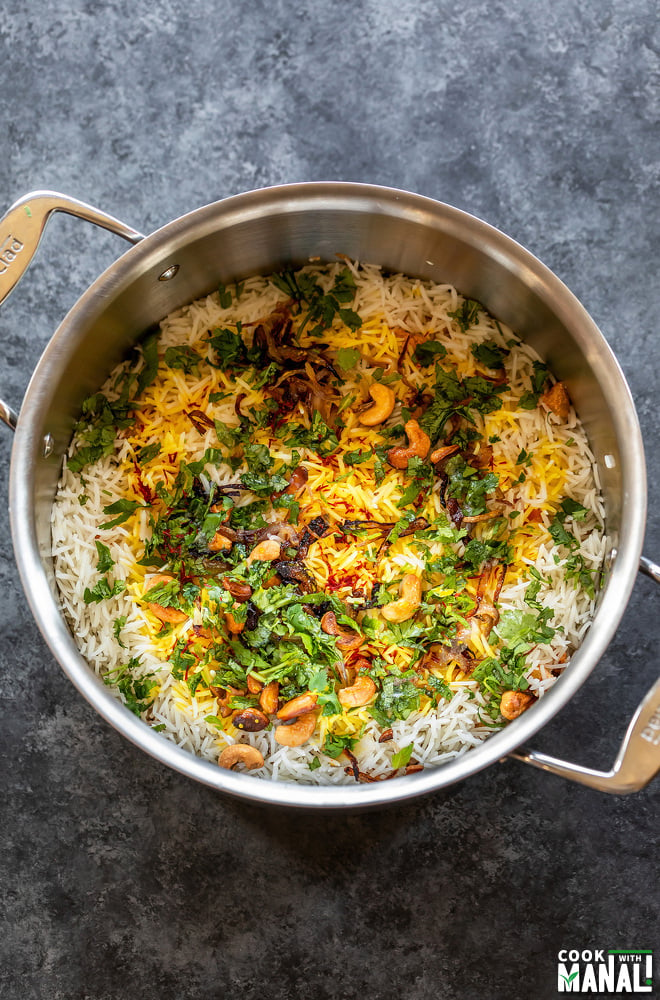
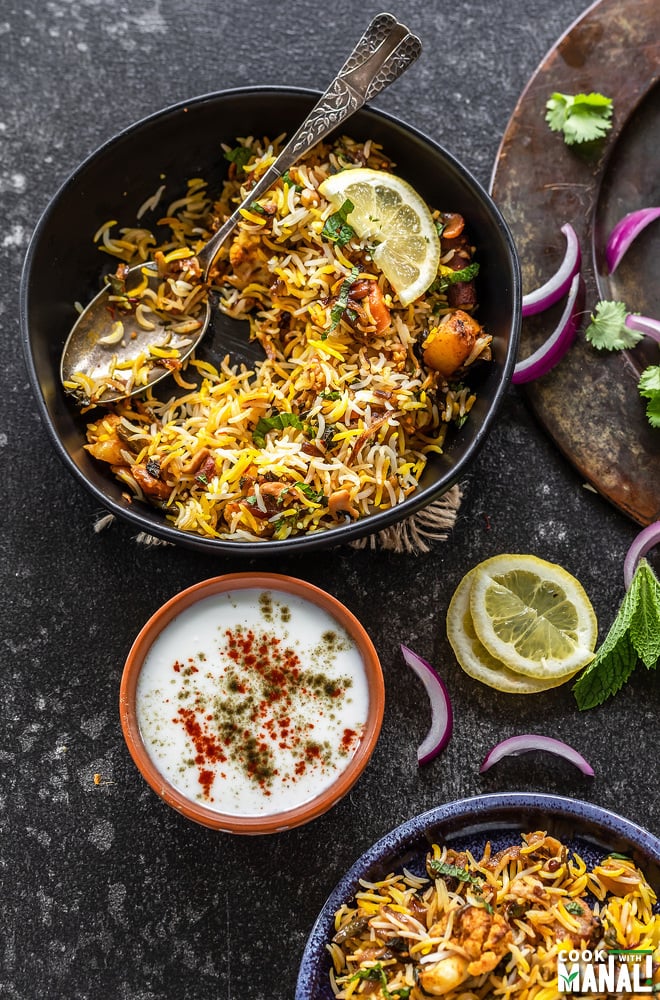
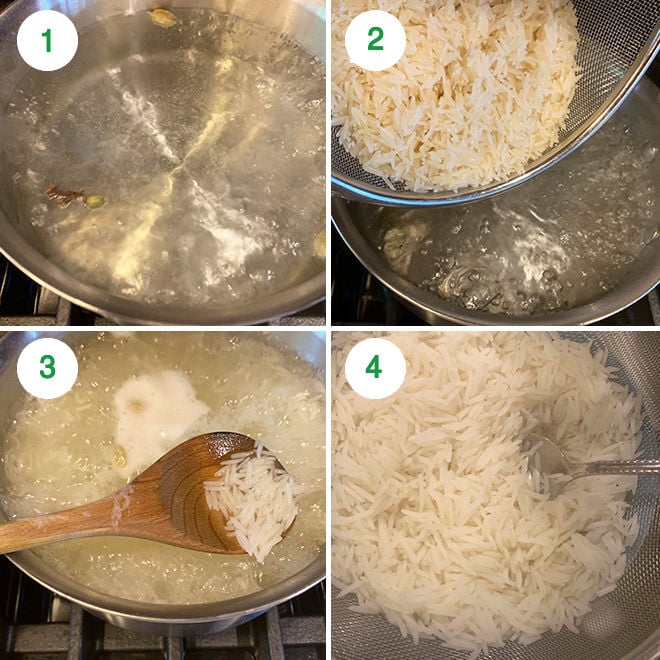
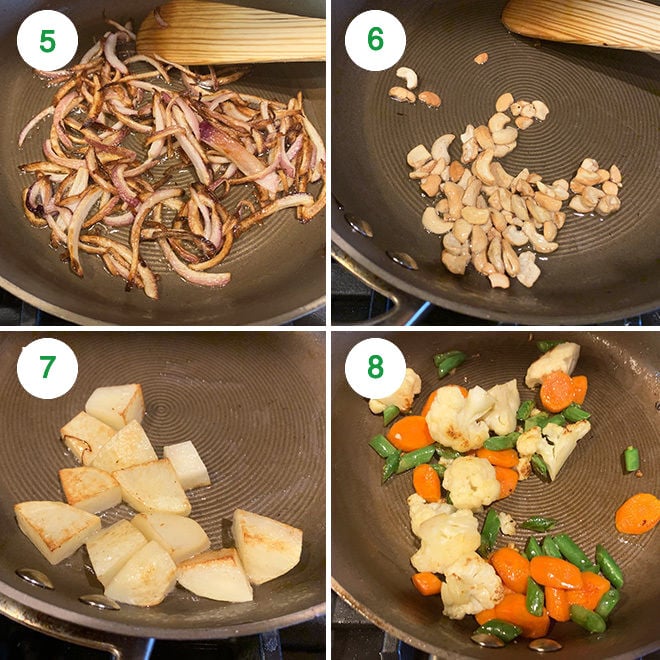
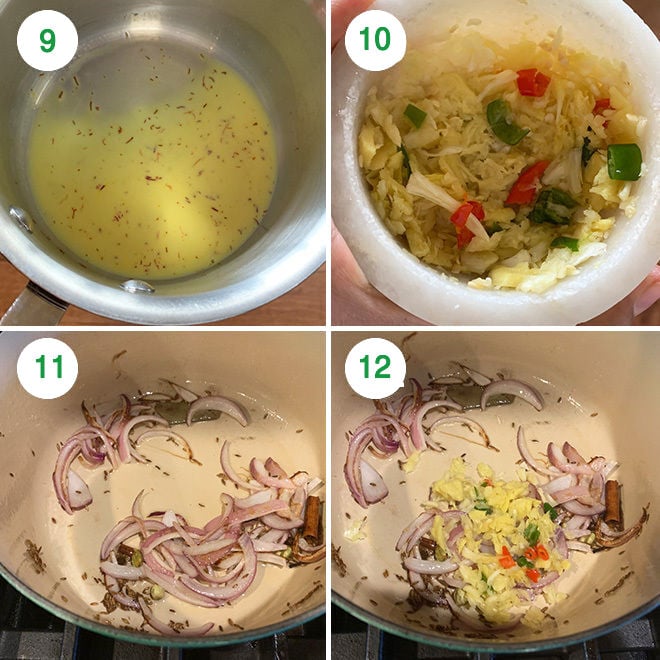
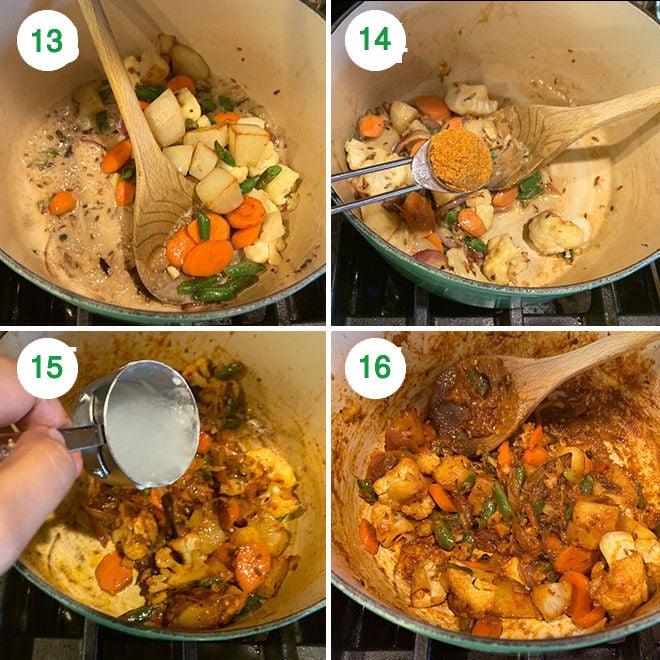
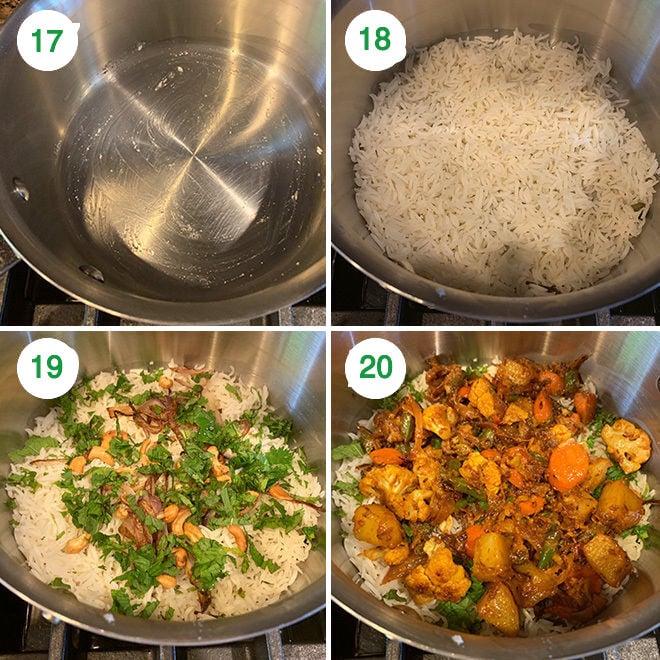
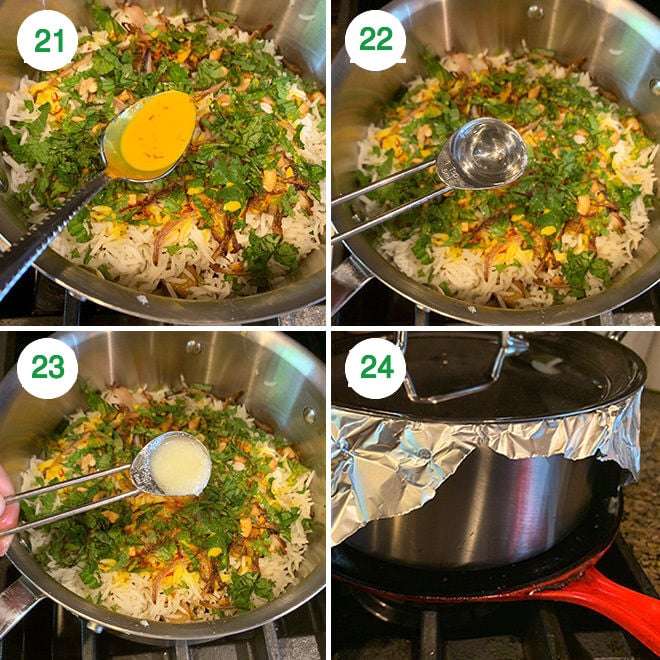
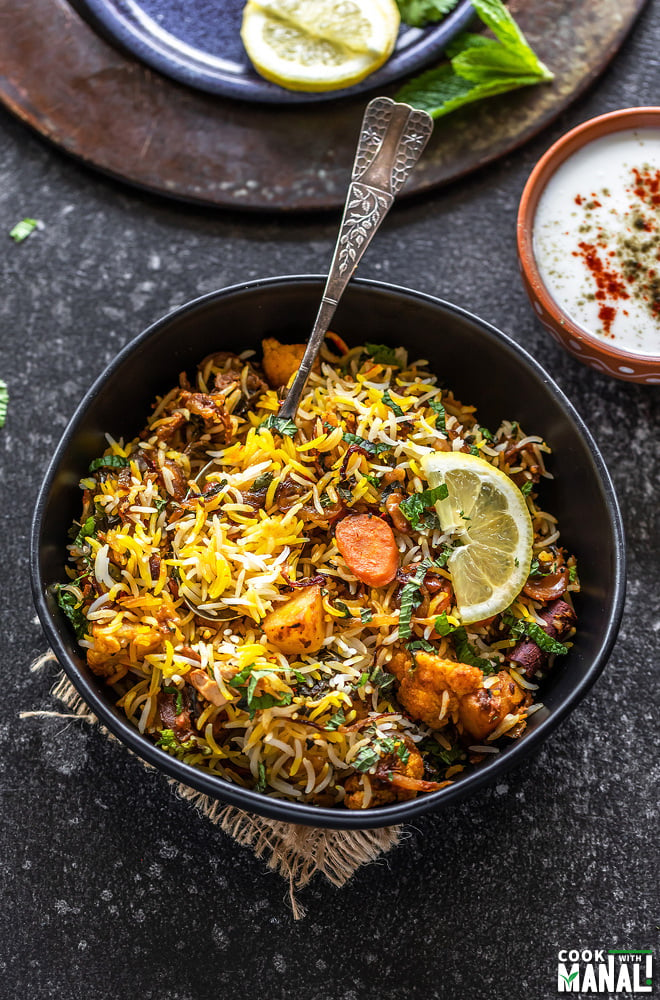

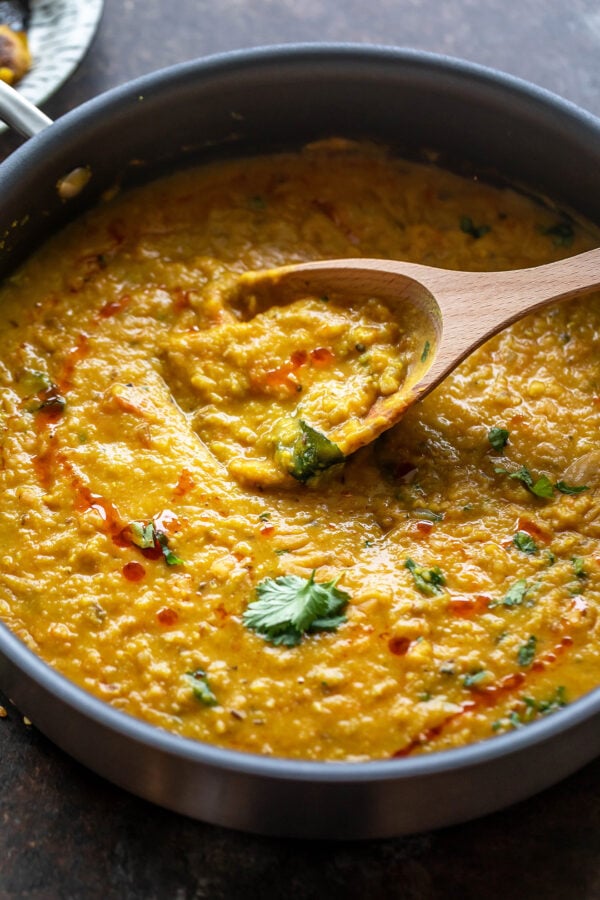
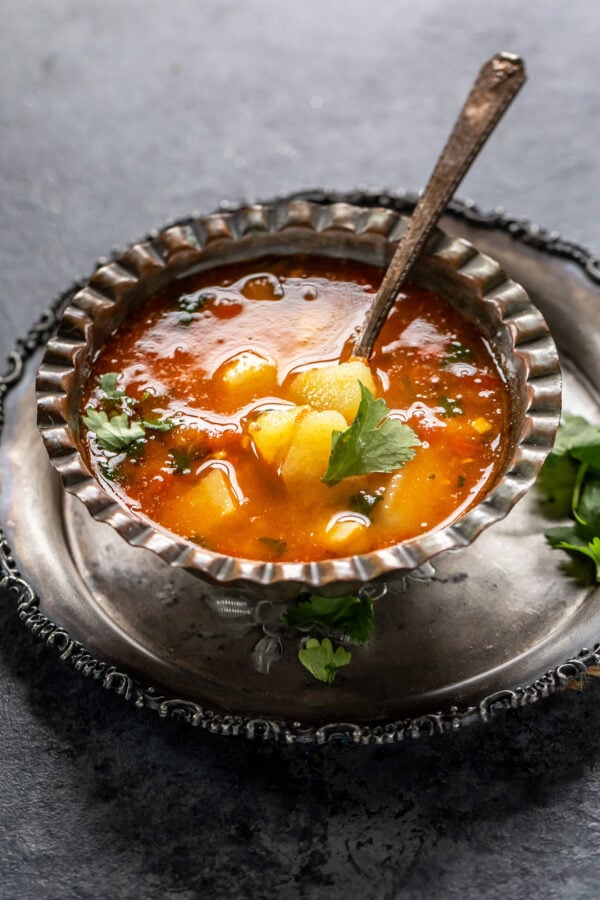
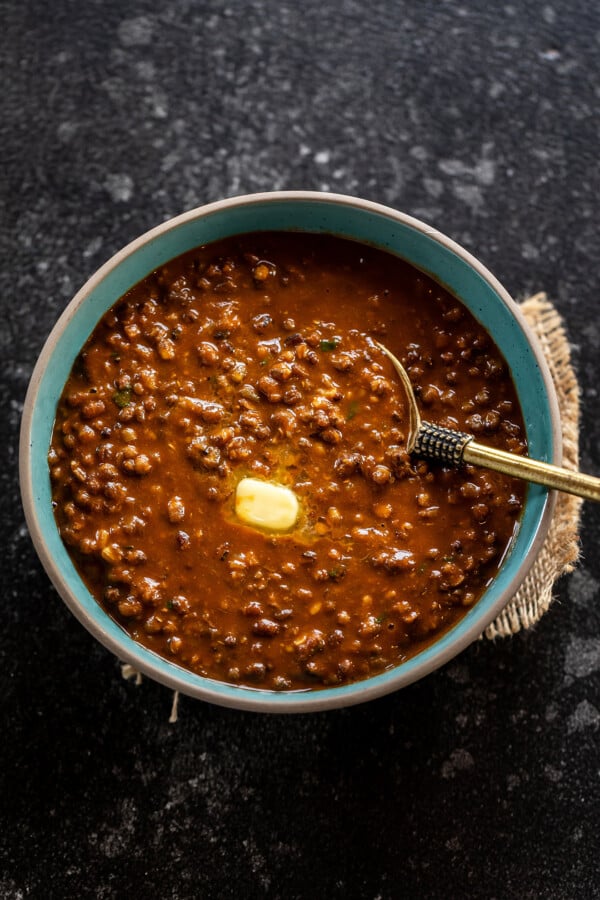
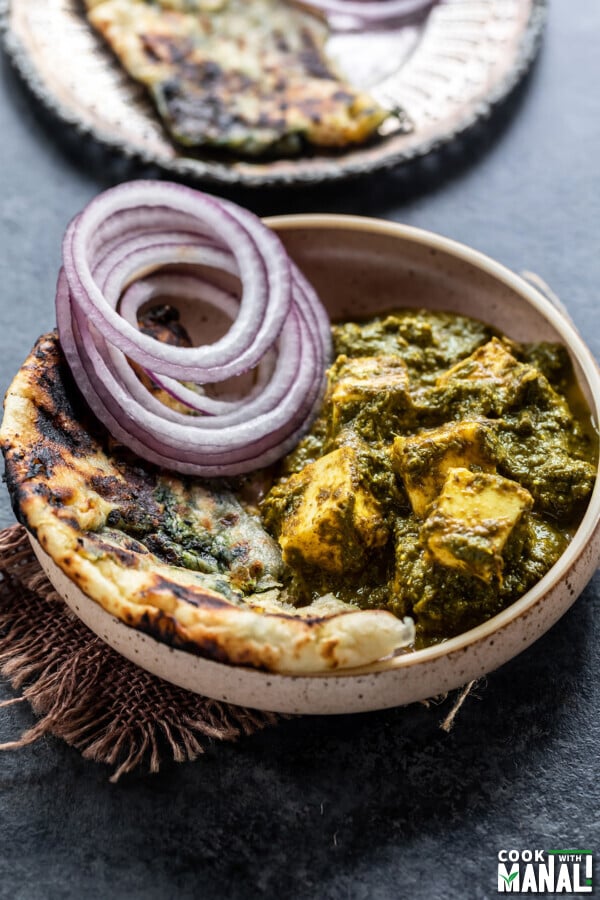









Hi Manali! Thanks for this recipe! Is it possible that in place of rice, I can use quinoa in the recipe?
You can, but the whole process will kind of change, quinoa might turn out mushy in this whole process. I would make a one-pot quinoa pulao rather than going for this layering process with quinoa because I am not sure it will work the same way.
I often see “green chilies” listed as an ingredient in Indian recipes. Can you tell me what kind of chilies are intended? Does this mean raw jalapenos? Or another type of pepper?
use Thai chili peppers when an Indian recipe calls for green chilies, hope this helps!
This recipe tasted amazing but I used the 3x ingredient calculator setting…. sadly the instructions didn’t update accordingly. Which made the whole process excruciating.
Hi Sarah, thanks for trying! The instructions won’t update unfortunately nor the measurements on the right side, it’s a plugin thing and there’s recipe no plugin which would update the instructions when you do 2x, 3x. Glad you liked the taste!
Hello
I don’t have a flat pan
So, can I place the Biryani pot on top of a pre-heated cookie sheet and cook/steam the Biryani in the oven?
Ta
Holley
yes should work!
Is it possible to double this recipe to serve more people? Would that change the cooking time?
It is possible to double, the time it takes to cook the vegetables will change a bit (more) but the end step of keeping the biryani on low heat and giving it “dum” will remain same.
Came out perfectly delicious.
i make this Vegetable Biryani today at home to follow your steps, and the result was awesome!
I love biriyani.
Very well Explained for a novice cook like me.
Trying it out today – keeping fingers crossed.
Hi Manali thanks for the awesome recipes ..just a request that can you post cups for onion, potatoes or carrots.. it’s very easy and perfect measurements. Bcos medium or small potatoes don’t know how small or medium I should consider.
Thanks
I will try and do that Pooja!
Hi Manali – we are vegans and yours is my favourite all time biryani! I use a mix of coconut milk and yoghurt and it works really well. plus – I make it ahead and put in oven (as you suggest) in an old lacruset pot with well fitting lid. many compliments including from non vegetarians! dawn
Thanks Dawn, so glad you all enjoy it!
This was very good. Definitely worth the time to individually pan fry the vegetables & follow all the steps. I substituted the ghee for avocado oil. For the sauce I used coconut oil. I used sliced almonds toasted in the pan instead of cashews. The final dish was excellent. Rice cooked perfectly & beautifully spiced. The vegetables were delicious. Served with warm naan bread. Everyone came back for more 10/10! Thank you!
welcome Marie, glad you liked it!
Hi Manali. Thanks for sharing your recipe. I am looking forward to trying it. After layering the biryani, you instruct to place your biryani pot on top of a pre-heated flat pan and let it cook for 25 to 30 minutes on lowest heat (dum). What is the purpose of putting the pot on top of the pan? Would it be okay to just put the pot directly on the stove and cook it at the lowest temperature for the 25 to 30 minutes?
Hi Debi, this process is called “dum” and this is how its traditionally done for biryani. We need very low heat so basically we need a layer in between for this process. The vapors from the spices, herbs everything mixes together with the rice this way. Hope this helps!
Thanks for explaining “dum”. I will follow your instructions exactly as written.
Hi Manali,
Is it possible to make this ahead of time and then reheat using the same method? i.e. placing the biryani saucepan on top of a flat hot pan and steaming? If yes, how long would you recommend steaming it for to warm it up? Open to other suggestions too, thanks!
I would make the whole recipe using an oven safe container (like all clad steel pot i have used here or a dutch oven). Then next day, just place the entire thing in oven. 250-300 F for 20-25 mins should be good!
Hi Manali. I’m looking forward to making this recipe. Had a question though. Is there a ratio for the rice to water for cooking the rice?
there’s no ratio but you can fill the pot with 6-8 cups of water. You only need to boil the rice until its 75% cooked so the ratio doesn’t matter here